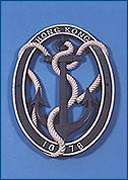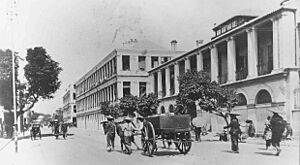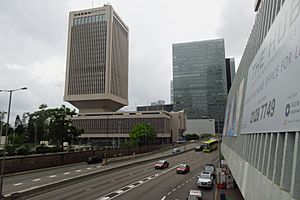HMS Tamar (shore station) facts for kids
Quick facts for kids HMS Tamar |
|
|---|---|
| Stonecutter's Island, Hong Kong | |

Gate emblem
|
|
| Type | Naval base |
| Site information | |
| Controlled by | RN |
| Site history | |
| Built | 1897–1997 |
| In use | 1897–1997 |
| Battles/wars | Battle of Hong Kong 1941 |
| Garrison information | |
| Past commanders |
Commodore-in-Charge, Hong Kong |
| Garrison | British Forces Overseas Hong Kong (naval) |
HMS Tamar (which means "添馬艦" in Chinese) was the main base for the British Royal Navy in Hong Kong. It operated from 1897 until 1997. The base was named after an old ship called HMS Tamar, which was used as the base itself before buildings were built on land.
Contents
The Story of HMS Tamar
The British Navy first came to Hong Kong during the First Opium War. This was a conflict where they aimed to protect traders. On January 25, 1841, Sir Edward Belcher landed in Hong Kong. He was on a ship called HMS Sulphur. A street called Possession Street still exists today to remember this important event.
The very next day, on January 26, 1841, Commodore Sir Gordon Bremer officially claimed Hong Kong as a British colony. He raised the Union Jack flag. Soon after, in April 1841, sheds were built to store naval supplies. This area was known as the "HM Victualling Yard."
Early maps show that more construction happened between 1845 and 1855. The Navy later gave up some land near West Point. In return, they received land where the Admiralty station of the Mass Transit Railway is now.
The Second Opium War (1856–1860) led to a bigger military presence. Because of this, the naval yard grew westward in April 1858. A "victualling yard" was added. This yard stored dry goods and food for the ships.
The original HMS Tamar was a large ship built in 1863. It weighed 3,650 tons and was used to transport troops. It visited Hong Kong a few times before arriving permanently on April 11, 1897. The ship stayed in the harbour as the base until 1941. During the Battle of Hong Kong in World War II, the ship was sunk on purpose. This was done to stop the invading Japanese forces from using it.
At the start of the 20th century, the Navy needed more space. They couldn't get land nearby because it was surrounded by army barracks. So, in 1902, they started building a sheltered bay (a "floating basin"). They also reclaimed land (created new land from the sea) for the dockyard. This huge project involved creating 160,000 square meters of new land. It also included a large basin for repairing ships and a 183-meter dry dock. The project was finished by 1908.
After World War II
After World War II, the Royal Navy set up its base again. They used the Wellington Barracks, which the British Army had left.
In 1957, the Navy announced that the dockyard would close. However, in 1959, they decided to plan a smaller naval base on the same site. From 1959 to 1962, the Wellington Barracks were updated. Old naval buildings were torn down. The leftover materials were used to fill in the dry dock in October 1959.
The Royal Navy then decided to build a modern naval facility. The Prince of Wales Building was finished in 1978. It became the main building for the new HMS Tamar base.
The End of HMS Tamar
Before the British forces left Hong Kong in 1997, the Tamar basin was also filled in. The People's Liberation Army of China then took over the Prince of Wales Building. It is now called the Chinese People's Liberation Army Forces Hong Kong Building.
The naval base was moved to the north side of Stonecutter's Island. This happened before Hong Kong was handed over to China in 1997. On April 11, 1997, the British naval base in Hong Kong was officially closed. This was just over 100 years after the original HMS Tamar ship arrived to serve as the base.
The last HMS Tamar site on Stonecutters Island is now a government marine facility. It is known as the Government Dockyard. The old site in Central, Hong Kong, is now called the Tamar site. After much discussion, this valuable land became the location of the new Hong Kong Government's Central Government Complex.
Many naval squadrons and fleets used HMS Tamar as their home base. These included:
- China Squadron (1844–1941, 1945–1992)
- Far East Fleet/HK Sqdn (1969–1971)
- Dragon Squadron (1971–1992)
- 3 Raiding Royal Marines
- Hong Kong Royal Naval Volunteer Reserves (1967–1996)
- 120th Minesweeping Squadron (1958–1966)
- 6th Mine Countermeasure Squadron (1969–1997)
- 6th Patrol Craft Squadron (1970–1997)
- Operations and Training Base (1934–1997)
- 3 Commando Brigade Royal Marines
- British Pacific Fleet (1840s–1948)
- HK Flotilla (1840s–1941, 1948–1992)
- China Station – including Submarine, Yangtse, West River, and Destroyer Flotillas
- 5th Cruiser Squadron
- 1st Escort Flotilla
- Frigate Squadron (1952–1976)
- Light Cruiser Squadron
- 415 Maritime Troop
- Naval Party 1009 (Hovercraft Unit)
The Royal Navy used or built many facilities in Hong Kong. Here are some of them:
- Prince of Wales Building (1978–1997) – now part of the Central Barracks
- Lamont and Hope Drydocks
- Aberdeen Docks (destroyed)
- Dry Dock (1902–1959)
- Taikoo Dockyard – now Hong Kong United Dockyards
- Royal Navy Dockyards (1902–1959)
- Sai Wan Barracks (1844–1846)
- Wellington Barracks (1946–1978) – later demolished
- North Barracks (1850s–1959)
- Victoria Barracks
- Redoubt and Lei Yue Mun Fortifications (1885–1887)
- Lei Yue Mun Fort (1887–1987)
- Reverse, Central, West and Pass Batteries (1880s)
- Brennan Torpedo station (1890) – at Lei Yue Mun
- Royal Naval Hospital, Wan Chai – now Ruttonjee Sanatorium
- Seaman's Hospital (1843–1873)
- RMS Queen Mary (1945–1946) – used as a hospital ship
- War Memorial Hospital (Matilda) (1946–1959)
- British Military Hospital (1959–1995)
- Island Group Practice (1995–1997)
- HMS Charlotte and HMS Victor Emmanuel – used as Receiving Ships
- Tidal Basin (1902–1959)
- Boat Basin (1902–1959)
- HM Victualling Yards (1859–1946)
- Guard Room
- Chichester Block
- HMS Minden (1841–mid-1840s) – hospital ship
- HMS Alligator (1840s–1865) – hospital ship
- HMS Melville (1860s–1873) – hospital ship
Ships at the Base
The base also had its own duty boats. These included the Victoria and RN Ferries (like T1, T2). These ferries transported service personnel across Victoria Harbour. They had three stops: HMS Tamar (Admiralty), Stonecutter Island (British Military Base), and Kowloon Public Pier.
See also
- British Forces Overseas Hong Kong
- HMNB Singapore
- People's Liberation Army Hong Kong Garrison
- Ngong Shuen Chau Naval Base
- RM Tamar




